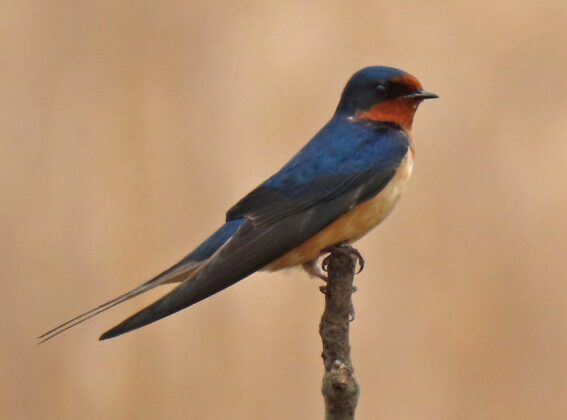A farmer friend of mine said that he knew the chance of frost was past because his barn swallows had arrived. He has a dozen or more of the birds that have been nesting in the out buildings of his farm for more than 30 years.
The swallows are a sure sign of warm weather because they don’t arrive until insects begin to hatch. A late frost would be very detrimental to them because it would kill the insects that they need for food.
Barn swallows have beautiful markings. Their back is a dark glossy blue. The female’s belly is a cream color, but the males are orange.
The male has a longer forked tail than the female. These forked tail feathers allow the birds to have agility during flight. Some ornithologists believe that females are attracted to males that have the longest tail feathers.
In the late 1800s, barn swallows were killed by the thousands for their colorful feathers, which were used to decorate ladies’ hats.
Swallows forage for food in open areas, and they often fly behind farm machinery or lawn mowers and feast on the insects the machinery stirs up. Their aerial acrobatics are interesting to watch as they bank swoop, and dive through the air, catching insects.
Their short, broad bill can be opened wide, and the bristles around the beak help funnel prey into their mouths. The birds also use their funnel-like bills to drink water. Their mouth is held open as the birds skim along the surface of the water.
Colonies of mud nests attached to barn rafters are a distinguishing characteristic of barn swallows. My friend’s barn and storage shed have over two dozen nests, and some have been used for many years. The nest must be sheltered from rain so the mud does not dissolve. Nesting in colonies allows the birds to protect each other from predators and to share information about food sources.
Swallows build their nests by scooping up a mouthful of mud and rolling it into a pellet along with a few blades of grass. They then use their beaks like a trowel to construct the nest, laying the pellets much as a brick layer builds
a wall. It takes the adult birds six to 12 days and hundreds of mud pellets to complete the structure. When the mud dries, it has a hard texture similar to adobe that will last for many years.
The female lays three to five eggs in the nest that has been lined with soft grass or animal hair. She will also line the nest with feathers from her breast. The bare breast forms a “brood pouch,” an area of bare skin that allows the female’s body heat to be transferred to the developing embryos in the eggs.
Swallows will normally have two batches of young in a summer. The first group of young stay near the parents and will frequently help feed the second hatch of babies.
By the end of September, the swallows begin to form large flocks as they prepare for the winter migration to Central and South America. Hundreds of them are frequently seen sitting on fences and electrical wires, neatly spaced a wing span apart from each other.
The barn swallow is a common bird in Iowa and is not endangered. However, ornithologists are reporting a slight decrease in their numbers. This is due in part to pesticides and Bt corn that has reduced the corn borer population.
Another reason for their decline is that many farmsteads lack the older wooden barns and sheds. New metal buildings on farms are tightly sealed, and the birds cannot get inside to build nests.
My friend likes to have barns swallows on his farm because they eat many insect pests, so he makes sure there is an opening in his sheds and barn so the swallows can return and nest on his property every year.




















